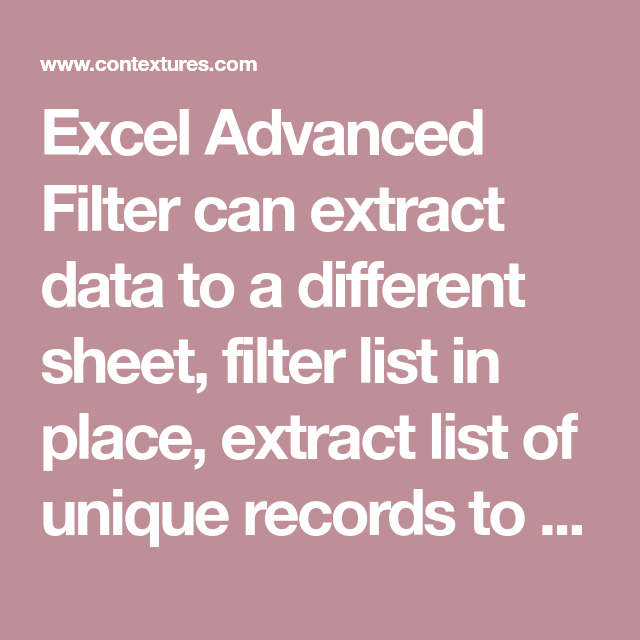5 Ways to Filter Excel Data Across Sheets

Excel, with its robust set of features, empowers users to manage and analyze data efficiently. Among its many capabilities, one of the most useful functions is the ability to filter data across sheets. Whether you're a business analyst, a data entry specialist, or just someone who loves organizing data, knowing how to filter data across different sheets can save you time and increase your productivity. In this blog post, we will delve into five practical methods to filter Excel data across sheets.
Method 1: Use of Filter Command

Excel’s basic Filter command allows for a quick and simple way to sift through data:
- Select Your Data: Click on any cell within the range you want to filter.
- Activate Filter: Go to the Data tab and click on Filter. Small filter dropdown arrows will appear in each column header.
- Apply Filter: Click on these arrows to apply filters on individual columns.
💡 Note: This method is most effective for static, one-off filtering tasks.
Method 2: Advanced Filter with Criteria Range

When dealing with more complex filtering needs:
- Set Up a Criteria Range: On a separate sheet or area, define the criteria for filtering. For example, a column labeled “Department” with criteria like “Sales” or “Marketing.”
- Use Advanced Filter: Select your data, navigate to Data > Sort & Filter > Advanced, and choose the Criteria range you’ve set up.
- Copy or Filter In-Place: You can choose to copy the filtered results to another location or filter the list in place.
Here’s an example of how to set up an advanced filter:
| Employee | Department | Sales |
|---|---|---|
| Sales |

🛈 Note: Advanced Filters offer flexibility but require familiarity with Excel’s filtering capabilities.
Method 3: VBA for Custom Filtering

Visual Basic for Applications (VBA) opens up advanced Excel manipulation:
- Open VBA Editor: Use
Alt + F11orDeveloper > Visual Basic. - Create a New Module: Insert a Module, and write your VBA script.
- Run Your Macro: Execute the macro to filter data.
Sub FilterAcrossSheets()
Dim ws As Worksheet
For Each ws In ThisWorkbook.Worksheets
If ws.Name <> "Sheet1" Then 'Assuming criteria is in Sheet1
ws.Activate
ws.UsedRange.AutoFilter Field:=2, Criteria1:="Marketing"
End If
Next ws
End Sub
Method 4: Power Query for Dynamic Filtering

Power Query is Excel’s powerhouse for data transformation:
- Create a Query: Select a cell within your data and go to Data > From Table/Range.
- Filter the Data: Use the “Home” tab to apply filters or transformations.
- Merge Queries: If your data spans multiple sheets, you can merge queries.
- Load Query: Load the query into a new sheet for the filtered results.
🔍 Note: Power Query is particularly useful for regularly updating data or combining multiple datasets.
Method 5: Dynamic Ranges with Named Formulas

For continuous, updatable filtering:
- Define a Named Formula: Go to Formulas > Name Manager, create a new name, and enter a formula to define a dynamic range.
- Set Up Filtering: Use Excel’s built-in Filter function on this dynamic range.
=OFFSET(Sheet1!$A$1,0,0,COUNTA(Sheet1!$A:$A),COUNTA(Sheet1!$1:$1))
Ultimately, understanding how to filter data across sheets in Excel provides immense versatility in managing data. Each method outlined here serves different needs, from quick, one-off filtering with basic filters to more complex, automated, or dynamic data management with VBA, Power Query, and named formulas. By mastering these techniques, you'll be well on your way to becoming an Excel power user, capable of handling vast datasets with ease and precision.
The key takeaway is to match your filtering method to your specific requirements. For simple filtering, the basic filter command or advanced filters might suffice. For dynamic data that changes regularly, Power Query or named formulas can be more effective. If you're dealing with complex data manipulation and multiple sheets, VBA scripting could be your go-to solution. Remember, Excel's true power lies in its versatility and the ability to combine these methods for the most optimal workflow tailored to your needs.
Can I filter data from multiple sheets using the basic filter command?

+
The basic filter command in Excel allows filtering within a single sheet. For multi-sheet filtering, consider using advanced filters, VBA, or Power Query.
What happens to data not meeting the filter criteria?

+
Filtered data is hidden temporarily, not deleted. You can unhide it by clearing all filters.
How often should I update my Power Query filters?

+
Power Query should be refreshed whenever the underlying data changes, to ensure your filtered results are up-to-date.
Is VBA scripting necessary for multi-sheet filtering?

+
Not necessarily. While VBA is powerful, Power Query or advanced filters can also manage multi-sheet filtering without coding.
How can I make my filtering process more efficient?

+
Use dynamic named ranges or Power Query for automated data updates, and consider scripting or automating repetitive tasks with VBA.